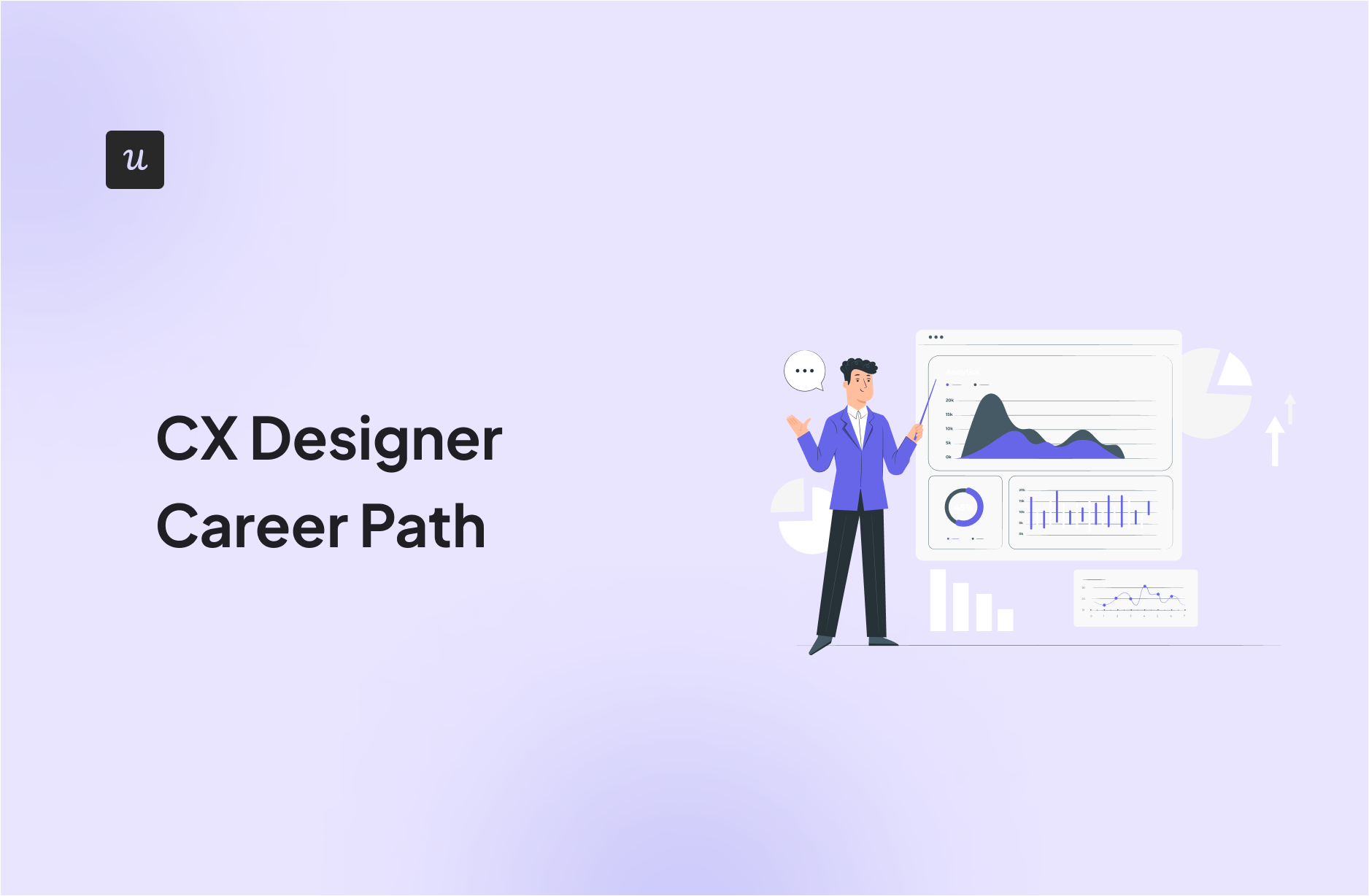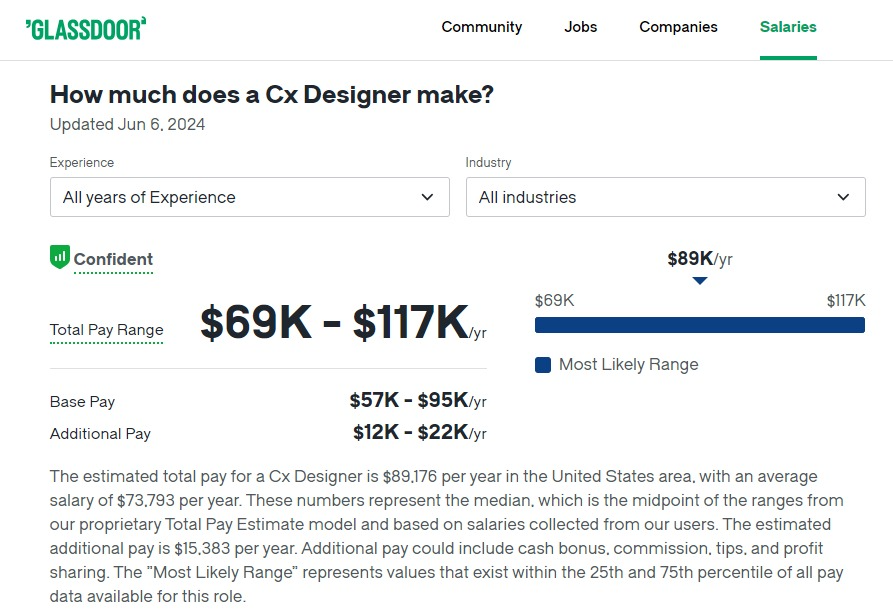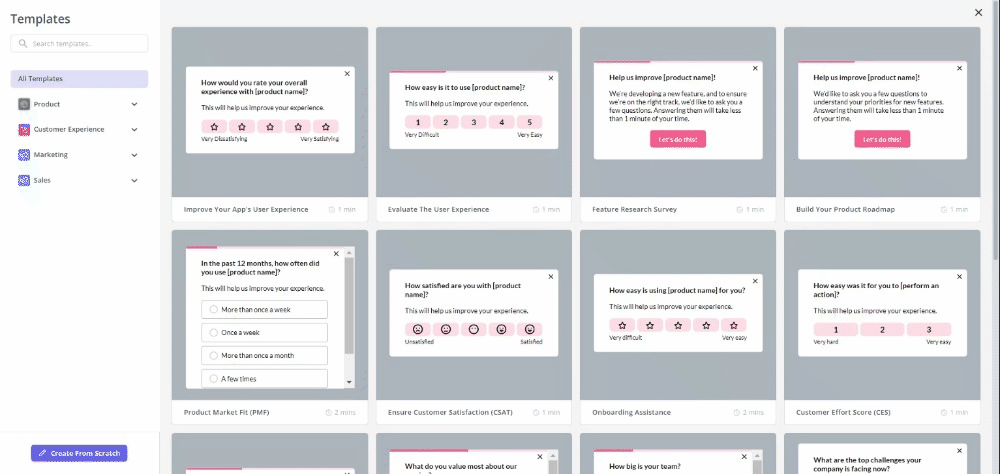
Try Userpilot Now
See Why 1,000+ Teams Choose Userpilot

CX designer career path – quick summary
- A customer experience designer (CX Designer) focuses on creating and optimizing the interactions that customers have with a company’s products or services.
- A customer experience designer (CX designer) is responsible for crafting and optimizing the entire journey a customer takes when interacting with a company’s product or service. This role involves conducting user research to gather insights on customer needs and pain points, designing intuitive user interfaces and interactions, and creating detailed customer journey maps.
- According to Glassdoor, the average base salary for a customer experience (CX) designer in the United States is $89,176 per year.
- Progressing in a career as a customer experience designer typically involves moving through various roles that build on increasing responsibility and expertise. Here’s a typical career progression:
- Junior Customer Experience Designer
- Customer Experience Designer
- Senior Customer Experience Designer
- Lead Customer Experience Designer
- Customer Experience Manager
- Senior Customer Experience Manager
- Director of Customer Experience
- To enhance productivity and collaboration, customer experience designers utilize a variety of tools tailored to different aspects of their work. Here are some essential tools for various use cases (keep reading for more):
- Best tool for User Onboarding and Engagement – Userpilot
- Best tool for Project Management – Monday
- Best tool for Product Management – Jira Software
- Best tool for Customer Experience – Zendesk
- Best tool for Customer Success – ClientSuccess
- Best tool for UX/UI Design – Figma
- Looking into tools for CX designers? Userpilot is an all-in-one product platform with engagement features and powerful analytics capabilities. Book a demo to see it in action!
What is a CX designer?
A customer experience designer (CX Designer) focuses on creating and optimizing the interactions that customers have with a company’s products or services.
This role is dedicated to enhancing every touchpoint in the customer journey to ensure a seamless, engaging, and satisfying experience. In the SaaS industry, a CX Designer uses user research, data analysis, and design thinking to improve user interfaces, streamline onboarding processes, and ensure ongoing customer satisfaction.
They collaborate closely with product managers, developers, and marketing teams to align the product’s design with the overall business goals and customer needs.
What does a CX designer do?
A customer experience designer (CX designer) is responsible for crafting and optimizing the entire journey a customer takes when interacting with a company’s product or service.
This role involves conducting user research to gather insights on customer needs and pain points, designing intuitive user interfaces and interactions, and creating detailed customer journey maps.
CX designers work collaboratively with product managers, developers, and marketing teams to ensure a cohesive and engaging experience across all touchpoints. They use data analysis to identify trends and make informed design decisions, continually iterating on prototypes and testing to enhance the overall user experience.
Their ultimate goal is to ensure customer satisfaction, loyalty, and retention by making every interaction with the product seamless and enjoyable.
CX designer’s main responsibilities
A customer experience designer plays a crucial role in the SaaS industry, focusing on optimizing the entire customer journey to enhance satisfaction and loyalty. Here are the main responsibilities and duties of a customer experience designer:
- Conduct User Research: Gather insights into customer needs, behaviors, and pain points through surveys, interviews, and usability testing to inform design decisions.
- Develop Customer Journey Maps: Create detailed journey maps that visualize the end-to-end customer experience, identifying key touchpoints and opportunities for improvement.
- Design User Interfaces and Interactions: Craft intuitive and visually appealing user interfaces and interactions that enhance the overall user experience across all touchpoints.
- Collaborate with Cross-Functional Teams: Work closely with product managers, developers, marketers, and other stakeholders to ensure a cohesive and seamless customer experience.
- Analyze Customer Data: Utilize customer feedback and data analytics to identify trends, measure the effectiveness of design solutions, and make data-driven improvements.
- Create and Test Prototypes: Develop prototypes of new features or improvements and conduct usability testing to gather feedback and refine designs before implementation.
- Ensure Consistency in Design: Maintain design consistency across all customer-facing products and platforms, adhering to brand guidelines and design standards.
- Monitor and Evaluate Customer Experience: Continuously monitor and evaluate the customer experience, implementing iterative improvements based on user feedback and evolving customer needs.
- Advocate for Customer-Centric Design: Promote user-centered design principles within the organization, ensuring that customer needs are prioritized in all design and development efforts.
- Stay Updated with Industry Trends: Keep abreast of the latest trends, tools, and best practices in customer experience design to bring innovative ideas to the team.
CX designer salary
Customer experience designers are essential in crafting seamless and engaging user journeys. Their salaries vary significantly based on experience, industry, location, and the company they work for.
Salary by Experience Level
- Entry-Level (0-2 years): Typically earns between $54,380 and $60,998 per year.
- Mid-Level (3-5 years): Average salary ranges from $60,998 to $69,787 annually.
- Senior-Level (5+ years): Generally earns between $69,787 and $76,248 per year.
Salary by Industry
- Technology: $70,000 to $90,000 per year.
- Finance: $65,000 to $85,000 annually.
- Healthcare: $60,000 to $80,000 per year.
- Retail: $55,000 to $75,000 annually.
Salary by Location
- San Francisco, CA: Around $76,248 per year.
- New York, NY: Approximately $71,246 per year.
- Boston, MA: Around $68,379 per year.
- Chicago, IL: About $63,987 per year.
- Miami, FL: Approximately $58,863 per year.
Highest Paying Companies
- Amazon
- Apple
- Facebook (Meta)
- Microsoft
These figures provide a comprehensive overview of how a Customer Experience Designer’s salary can vary. For the most accurate and detailed information, consulting sources like Glassdoor, Salary.com, and Payscale are recommended.
CX designer career path
Progressing in a career as a customer experience designer typically involves moving through various roles that build on increasing responsibility and expertise. Here’s a typical career progression:
- Junior Customer Experience Designer – Entry-level position focused on assisting senior designers, conducting user research, and creating basic design components. To progress, focus on learning design tools, building a portfolio, and gaining practical experience.
- Customer Experience Designer – Responsible for designing user interfaces and experiences, conducting usability tests, and collaborating with cross-functional teams. To advance, take on more complex projects and deepen your understanding of user-centered design principles.
- Senior Customer Experience Designer – Leads major design projects, mentors junior designers, and plays a key role in strategic design decisions. Enhance leadership skills, contribute to creating design systems, and build strong relationships with other departments.
- Lead Customer Experience Designer – Oversees the design team, ensures design consistency across projects, and aligns design goals with business objectives. Develop project management skills and engage in high-level strategic planning.
- Customer Experience Manager – Manages the customer experience design team, coordinates design projects, and ensures alignment with business goals and user needs. Enhance leadership and managerial skills, stay updated with industry trends, and focus on optimizing team performance and design processes.
- Senior Customer Experience Manager – Manages larger design teams, oversees multiple projects, and plays a critical role in company-wide design strategy. Develop a vision for the customer experience department and mentor upcoming leaders.
- Director of Customer Experience – Sets the overall customer experience strategy for the company, collaborates with top executives, and ensures the design vision aligns with the company’s mission. Focus on strategic leadership and drive the company’s customer experience innovation.
Each step in this career path builds on the previous one, emphasizing continuous learning, leadership, and strategic thinking to progress to higher levels of responsibility and influence in the field of customer experience design.
How to become a CX designer
To become a customer experience designer, start by obtaining a bachelor’s degree in a relevant field such as design, human-computer interaction, psychology, or a related discipline.
Coursework should include user research, interaction design, and visual design principles. Gaining practical experience through internships is crucial; look for opportunities at tech companies, design firms, or startups where you can work on real projects.
Building a strong portfolio showcasing your work is essential. Additionally, consider taking online courses or attending workshops to stay updated with the latest design tools and trends. Networking through industry events and joining design communities can also help in securing job opportunities and mentorship.
Best resources for CX designers
To stay ahead in the dynamic field of customer experience design, leveraging a variety of resources is essential.
Here are some top recommendations for books, webinars, podcasts, and blogs that every customer experience designer should explore.
Best books for CX designers
Reading books by industry experts can provide deep insights and practical knowledge about customer experience design.
- “The Elements of User Experience” by Jesse James Garrett – Covers the fundamentals of user experience design.
- “Service Design: From Insight to Implementation” by Andy Polaine, Lavrans Løvlie, and Ben Reason – A comprehensive guide to service design principles.
- “Smashing UX Design” by Jesmond Allen and James Chudley – Provides practical advice and real-world examples for UX design.
- “Designing for Interaction” by Dan Saffer – Focuses on creating engaging and effective interaction designs.
- “Change by Design” by Tim Brown – Explores how design thinking transforms organizations and inspires innovation.
Best webinars for CX designers
Participating in webinars can offer real-time learning and insights from industry experts.
- Userpilot Webinars – Focused on user onboarding, engagement, and product growth.
- UXPin Webinars – Offers webinars on design systems, UX strategy, and prototyping.
- Interaction Design Foundation Webinars – Covers various aspects of UX design and usability.
- Baymard Institute Webinars – Provides insights into UX research and e-commerce usability.
- UX Design Institute Webinars – In-depth discussions on UX design principles and career development.
Best blogs for CX designers
Following blogs can help you stay updated on the latest trends, tips, and best practices in customer experience design.
- Userpilot Blog – Insights on user onboarding, product growth, and UX design.
- UX Booth – Articles on user experience, usability, and interaction design.
- Usability Geek – Focuses on usability, UX, and HCI (Human-Computer Interaction).
- NNG Blog (Nielsen Norman Group) – Research-based articles on UX design and usability.
- Smashing Magazine – Covers a wide range of topics, including UX design, web development, and product management.
Best podcasts for CX designers
Listening to podcasts is a convenient way to stay informed and inspired by industry leaders while on the go.
- “User Defenders” – Interviews with UX design heroes who share their stories and insights.
- “The Crazy One” – Hosted by Stephen Gates, covering creativity, leadership, and innovation in design.
- “UI Breakfast” – Conversations about UI/UX design, product strategy, and business.
- “What is Wrong with UX” – Two experienced UX designers discuss and critique current trends and practices.
- “Awkward Silences” – Focuses on user research and customer experience insights.
Best tools for CX designers
To enhance productivity and collaboration, customer experience designers utilize a variety of tools tailored to different aspects of their work.
Here are ten essential tools for various use cases:
- Best tool for User Onboarding and Engagement – Userpilot: Userpilot helps design personalized in-app experiences and onboarding processes to enhance user engagement and retention.
- Best tool for Project Management – Monday: Monday.com offers a visual platform for managing projects and tasks, facilitating efficient collaboration and progress tracking.
- Best tool for Product Management – Jira Software: Jira Software is ideal for tracking and managing development tasks, sprints, and releases, ensuring seamless communication between teams.
- Best tool for Customer Experience – Zendesk: Zendesk provides comprehensive customer support solutions, enabling efficient handling of customer inquiries, feedback, and support tickets.
- Best tool for Customer Success – ClientSuccess: ClientSuccess assists in managing and measuring customer relationships, ensuring customers achieve their desired outcomes with the product.
- Best tool for UX/UI Design – Figma: Figma supports real-time collaboration, making it perfect for teams working together on UX/UI design projects and creating interactive prototypes.
- Best tool for UX/UI Design – Sketch: Sketch is a vector graphics editor tailored for digital design, offering numerous plugins and integrations to streamline the design process.
- Best tool for Documentation and Collaboration – Confluence: Confluence is a collaboration tool that allows teams to create, share, and manage project documentation effectively.
- Best tool for Customer Feedback – Freshdesk: Freshdesk helps in collecting and analyzing customer feedback, improving the overall customer experience.
- Best tool for Data Analytics – Tableau: Tableau offers powerful data visualization capabilities, allowing teams to analyze and present data in an intuitive and visually appealing manner.
These tools collectively empower customer experience designers to create user-centric designs, manage projects effectively, and collaborate efficiently with their teams.
Conclusion
We hope our article has given you a good overview of the career path for CX designers.
Whether you’re just starting out or looking to advance, the key is to stay curious, keep learning, and remain open to new opportunities along the way.
Looking into tools for CX designers? Userpilot is an all-in-one product platform with engagement features and powerful analytics capabilities. Book a demo to see it in action!









